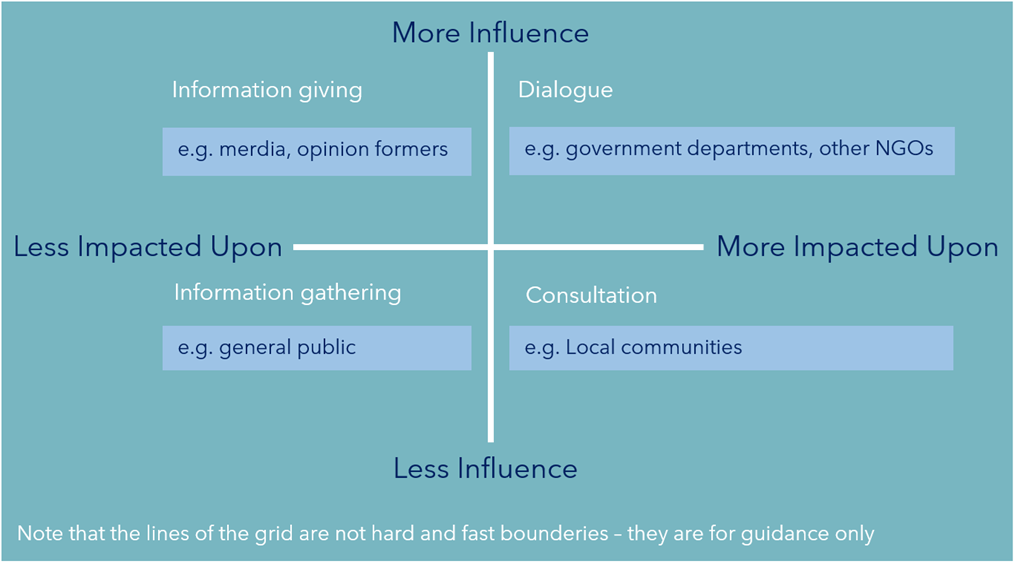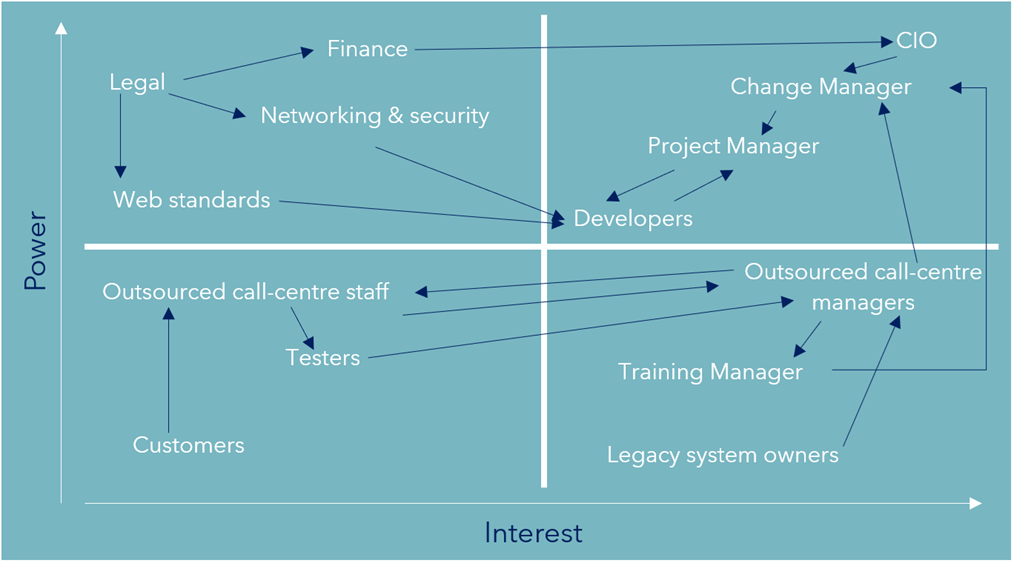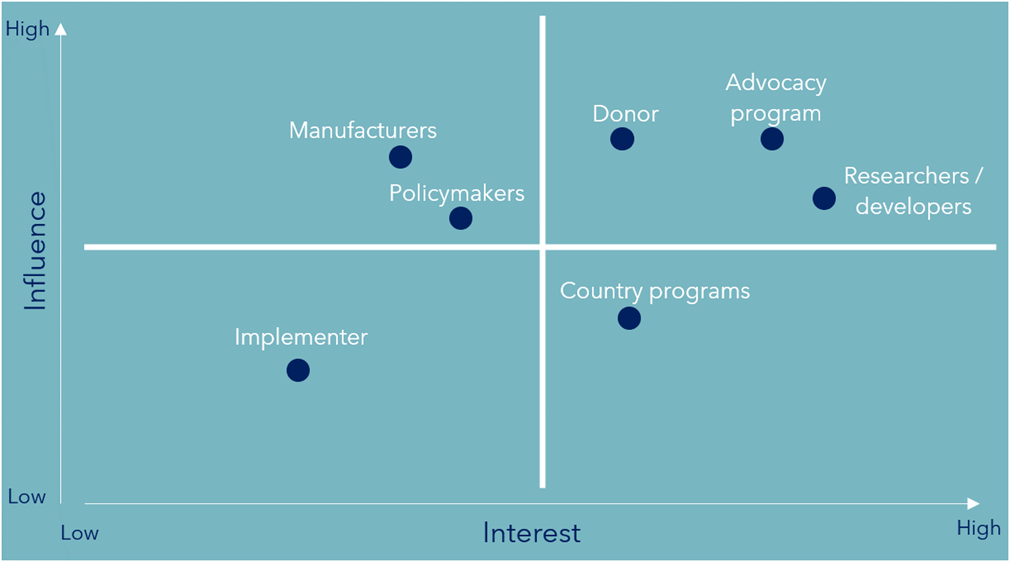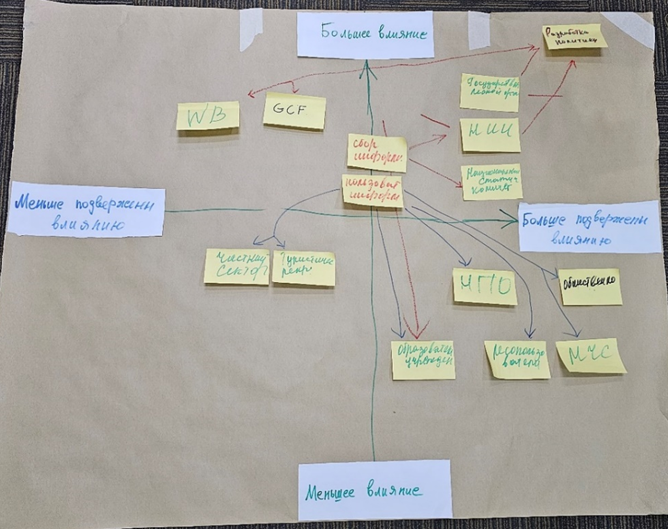Phase 0: Initiation of the programme
Carry out institutional mapping exercise
Objective of the exercise
Enhancing stakeholder understanding, promoting effective engagement in the context of forest information systems, managing stakeholder relationships, and ultimately improving project outcomes.
Introduction
What is a stakeholder?
Stakeholders are organizations and social groups of any size or individuals that act at various levels and in different sectors (domestic, local, regional, national, international, private and public). These actors have a significant and specific stake in a given set of resources, and can affect or be affected by resource management decisions.
What is a stakeholder analysis?
Stakeholder analysis is the process of systematically identifying, categorising, mapping and analysing information to determine:
- which groups have an interest and/or influence in a project;
- which groups are typically included or excluded;
- whether each group is relevant to include;
- which concerns are shared by various groups regarding the project;
- whether the groups support or oppose the project, or whether the groups will benefit or be harmed by it?
What needs to be analysed?
The process of identifying and analysing key stakeholders in a FIS analysis allows users to know their interests, positions, functions and roles, as well as their degree of involvement and ability or inability to affect policy change.
The mapping helps managers and organizations (e.g. government agencies or forest management enterprises) to gain a better understanding of who their key stakeholders are, their interests and concerns, and how they can be effectively engaged or managed.
The mapping enables the identification of potential areas of collaboration or conflicts of interest, allowing for the development of appropriate strategies to address stakeholder needs and expectations. Stakeholder mapping also facilitates prioritizing stakeholder engagement efforts and ensuring that communication and decision-making processes are inclusive and transparent.
What are the steps in stakeholder mapping?
The following are the steps in stakeholder mapping:
- Plan the analysis;
- Identify stakeholders;
- Gather information;
- Fill in the Stakeholder Analysis Worksheet;
- Analyse the Stakeholder Analysis Worksheet;
- Apply the results.
Step 1. Plan the analysis
Defining the purpose and scope of a stakeholder analysis is the crucial aspect of this preliminary step before the actual investigation is undertaken. This involves:
- Identifying the objectives users wish to achieve;
- Determining which stakeholders need to be involved;
- Specifying the information required from each stakeholder;
- Identifying the intended information users;
- Determining how the information will be used to benefit the project.
Step 2. Identify stakeholders
The first step in stakeholder identification is to create a list of groups that are known to have an influence and/or interest in forest sector policies and activities. This list serves as a starting point to further expand and analyse the identified stakeholders. To gather a comprehensive understanding of the stakeholders involved or impacted by the forest sector, a literature review is necessary. This involves conducting online and print searches of various sources, such as legal documents, websites, scholarly articles, company profiles, media publications, government and non-governmental organization (NGO) reports. Through this process, a wide range of stakeholders can be identified and analysed.
At the beginning of the stakeholder identification process, it is important to create a comprehensive list of all actors that may have a potential interest in forest information systems. This list should not be constrained by pre-existing knowledge and assumptions on their involvement in potential future projects involving FIS implementation.
During the analysis and stakeholder engagement stages, there will be an opportunity to confirm the relevance of each group's interest. Stakeholders can be categorized into the following groups: state entities, private sector, donors, civil society, international organizations, local NGOs, international NGOs, academia, local leaders or influencers, and others.
Practical note: The range of services provided by forests is also reflected in the diversity of stakeholders. The composition and landscape of stakeholders varies from region to region and is also subject to change. Therefore, any stakeholder analysis presented here should be considered as a snapshot of the real situation. This applies in particular to the relationships between stakeholders, which can also change. The examples used in this document are therefore not a simple blueprint but should only serve as illustrations that may vary according to local conditions.
Step 3. Gather information
The initial lists generated through stakeholder identification rely on secondary sources. However, to gather more comprehensive information, it is important to reach out to project actors directly. There are three primary methods to collect information directly from stakeholders: (1) electronic communication, such as email or online surveys, (2) interviews conducted in person or via phone, and (3) workshops of focus groups consisting of multiple stakeholders. These methods provide opportunities to gather more detailed and nuanced information on stakeholder interests, positions, and concerns, as well as to establish stronger relationships with key stakeholders.
The goals of the analysis must be clarified before engaging stakeholders and be clearly communicated to them before conducting interviews. Goals help to identify and target those interests that need to be represented in the collaboration processes, and those that can be left out considering that stakeholders will come to the interview with their own biases (Golder and Gawler 2005).
When conducting interviews, a standard questionnaire can be used based on the categories of the Stakeholder Analysis Worksheet. The specific type of interview questions should be tailored to the project or policy context, as well as the cultural context of the interviewed stakeholders. For example, questions may focus on stakeholders’ positions on the issue at hand, inclusion or exclusion, alliances, conflicts, or other relevant topics.
To ensure consistency across interviews, it is recommended to develop a standard interview protocol that may include guidelines for how to ask questions, how to record the responses (e.g., notes or recording), and other relevant information. By using a consistent interview protocol, it will be easier to analyse and compare the responses from different stakeholders.
In addition to collecting information from known stakeholders, conducting interviews during the outreach phase can be a useful way to identify additional groups who may have an interest in, or be impacted by the project or policy. During the interviews, stakeholders can be asked to identify other groups who may not be on the initial stakeholder list but who may have relevant perspectives or concerns. This can help expand the list of stakeholders and ensure that all relevant groups are included in the stakeholder analysis process.
Step 4. Fill in the Stakeholder Analysis Worksheet
The Stakeholder Analysis Worksheet should be filled in using the following guidance.
1. What is the stakeholder’s primary interest in FIS?
Describe relations of stakeholder groups to forest information processing, their use and linked policies. For example, through expertise or knowledge of the area, as a key decision-maker, or by potential direct impact from developing FIS. Assign a value from 1-5 to the stakeholder’s interest. If the stakeholder has a high degree of interest, a rating of 5 should be given, if a low degree, a 1.
2. To what degree is the stakeholder group relevant to developing an FIS?
Assign a value from 1-5, five being the highest relevance, for each group listed. Within this column, the following questions can be answered: What is the current role of the stakeholder? What is the potential role of the stakeholder to the future FIS development? What is the potential contribution of the stakeholder to the FIS development?
3. To what degree is the group involved in the policymaking process?
A value from 1-5 should be assigned, 5 being the highest, and a written explanation should be given if necessary – taking into account how this group has been involved in decision-making on policy and policy formulation both historically and presently.
4. Does the stakeholder group support or oppose the FIS development?
A spectrum of stakeholder types that can be provided is: supporter, moderate supporter, neutral, moderate opponent, and opponent.
5. Will the developed FIS benefit or harm the stakeholder group?
Possible impacts are: benefit, harm, neither; how the groups will be affected should be explained.
6. What alliances exist with other stakeholders?
Any collaboration between relevant stakeholders should be listed and described.
7. What conflicts exist with other stakeholders?
Any conflicts between stakeholder groups should be described.
Step 5. Analyse the Stakeholder Analysis Worksheet
After gathering information on as many stakeholders as possible, the evaluator should analyse the data collected using the Stakeholder Analysis Worksheet. This analysis aims to gain a better understanding of each stakeholder group's interests, influence, positions, relevance, partnerships, and conflicts.
The scale of 1 to 5 used in the Worksheet provides a simple way to assign a numerical value to the set of criteria, based on the evaluator's opinion of the stakeholder group's characteristics. However, opinions can vary. Therefore, it is recommended to seek information and feedback from as many actors as possible to ensure a more accurate rating.
In addition, the question What is the stakeholder’s primary interest in FIS? is used to gain a clear understanding about the principal areas of interest of each stakeholder (or group of stakeholders). Furthermore, the response to this question helps to get to know which parts of the value chain they are linked to and what might be their likely position toward changes in the value chain elements.
The purpose of the question about degree of stakeholder relevance is to analyse how important particular stakeholders are for developing a FIS. An important issue is to realize what it means for the participants of this exercise to be “relevant” and to arrive at common understanding. This might be not so easy a task as opinions may be influenced by social factors and individual interests.
To what degree is the group involved in the policymaking process? The answer to this question depends on the formal structure of governance, but also on the actual estimated influence in decision-making.
Each group should be assessed to understand whether they support or oppose the project or policy to build FIS. In addition to classifying them into supporters, moderate supporters, neutral, moderate opponents, or opponents, it is important to look for the reasons for their position. It might happen that a group will be internally divided in their position, this should be described and, if possible, explained.
In addition to the perceived influence and position towards the project or policy, further analysis is recommended with a focus on analysing whether the stakeholder group will benefit or be harmed by the project. In particular, real or potential harm as well as financial or other benefits, should be analysed.
The final issue is understanding which alliances exist with other stakeholders. This form of linkage may foster collaboration and build support for the project or policy, but alliances might also be formed to oppose it. Therefore, if conflicts with other stakeholders exist (or could potentially appear) they need to be described.
Step 6. Apply the results
The analysis should be documented in the form of diagrams with attached explanations/descriptions. One of the diagrams frequently used for this purpose (Golder and Gawler 2005) is shown in figure below.

Another approach is to classify stakeholders by their power (influence) and interest. One may also visualize influence vectors – how the stakeholders can influence each other – see an example (Bryson 2018) in figure below.

The four quadrants of such a matrix can be mapped to different communication strategies. An example of this approach (Storey et al. 2019) is shown in figure below.


Practical note: The names of the stakeholders that have been identified earlier should be now placed on a diagram similar to those described in this section. A large sheet of paper with four named quadrants should be made available in the workshop venue. If sticky notes have been used previously, they can now be easily transferred to the analytical diagram. If necessary, vectors of influence can be then drawn directly on the diagram using table markers.